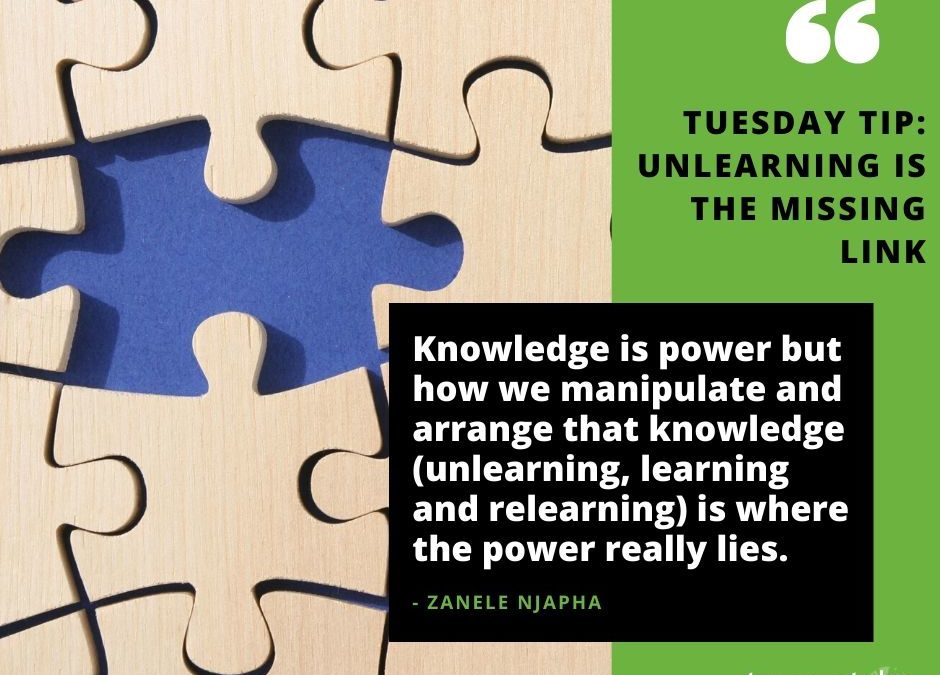We’ve all heard the saying ’knowledge is power’ but one can now argue that, in the Information Age, how we manipulate and arrange that knowledge (unlearning, learning and relearning) is where the power really lies.
In the first article of this ‘unlearning series’, I set the tone for unlearning and drove home the message that unlearning is yet the greatest part of learning. But what is unlearning and how does it relate to learning and building an organisation that is future-fit?
Learning, loosely defined is the acquisition of knowledge, skills and values or attitudes that were either not present, or are being upgraded or developed. Unlearning, then, can be seen as the opposite side of the coin. It is about a shift in outlook and challenging perspectives, asking questions and seeking out the contrast.
Unlearning begins with the understanding that some of the skills, tools and models made use of within our institutions and organisations are not only outdated but are detrimental to the growth of our organisations.
An example of this would be in sales, where a customer relationship management system is based on outdated knowledge around consumer insights. The consumer of the past is significantly different from the profiles we see today.
Current consumer insights tell us that the consumer of the 2020s is a co-creator in the product and service experiences they engage in. The consumer wants and can have access to the developments and moulding of the offering. If a team or organisation is not aware of this insight and is making use of systems that treat the consumer as a mere receiver and reactor within the sales process, they are at risk of stumping their growth.
It would then be of great importance that an organisation “empties their cup” and engages in what innovation and leadership advisor, Navi Radjou names ‘purposeful naivety.’
UnLearning Is A Process
The development and unlearning process is a balance between this purposeful naivety and already existing expertise. This is why experimentation plays a key role in unlearning, as a process of mindful ignorance, where new information and insights are sought after and teams engage in targeted questioning. This experimentation will continuously rely on contextual factors that will directly influence the scale at which you experiment and the involved resources.
Another factor that would come into play, advised by systems expert and author of The Fifth Discipline, Peter Senge, is ‘time’. Unlearning, as with creating a learning organisation, where development is an ingrained culture, is a process, and processes require patience.
Unlearning thrives under an organisation’s receptiveness to developing over time and allowing change and learning to occur gradually.
The future always lies ahead and because of this, the process of unlearning must be continuous, especially at the rate at which new and updated information becomes widely available.
A colleague shared with me the other day that his mobile device had reported that thirteen updates had been made to different applications on his device between breakfast and when we’d had our meeting just before lunch. Applications have taken on a culture of constant development that is informed by feedback from users and those who engage with their products and services. Instead of scheduling updates on a monthly or quarterly basis, updates are processed through a rapid system of receiving queries, analysing the breakdown and query, processing the adjustment and then releasing the updated version into market.
This is a clear example of the difference between a structure or organisation that views learning and change as a one-time event that is diagnosed and then treated, only to be run into in a year’s time again, and one where unlearning ‘the outdated’ is a way of life.
Just a few months ago, the world had their eyes on the 2019 Rugby World Cup, which took place in Japan. At no point did any of the coaches chat to their teams a month or so before they were due to play and then give them a month to rest. Coaches were consistently making changes, updating strategies, swapping players out and rethinking positioning for the entire lead-up to their debut game, and those that followed. Even on the sidelines and during ‘half-time’ or ‘water breaks’, there are constant changes being made.
In my experience of working with children, I’ve found their ability to unlearn is something to behold and learn from. I had the fortune of sitting next to a little girl at a coffee shop earlier this month. She’d come in to enjoy a warm drink with her mother and a mature lady who appeared to be her mother’s friend. As she bit into her delectable cinnamon bun, she smiled and once she had swallowed that mouthful, she joyfully exclaimed: “this is the best day of my life.” Her mother, to my surprise, responded by saying she’d heard that phrase from her before.
The little girl’s response to that, however, is what I want to bring your attention to. Without letting the moment escape, she piped up, “well it’s the new best day of my life.”
What now?
Note that within other areas of our existence, we are open to the culture of ongoing development and unlearning, however, in business, we tend to be more cautious, fearful and ‘resource-conscious’. Perhaps, then, weighing the gains and the losses against each other may be what is needed.
What do our organisations have to gain from having unlearning encoded in the very fibre of their DNA and how would it be to their detriment to have learning and unlearning remain a mere segmented and isolated activity?
I look forward to extending on this by exploring how unlearning helps build future-fit organisations and what happens to an organisation that fails to unlearn in the face of disruption. Reach out to me, should you wish to take the conversation further.


